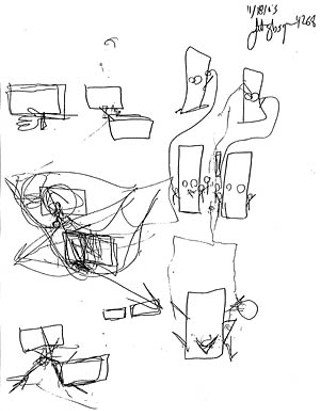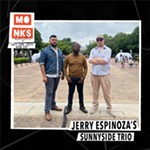Anatomy of a Shooting
Report on Owens incident leaves questions about the limits of APD policy
By Jordan Smith, Fri., March 12, 2004

On Feb. 20, the city made public the Austin Police Department's Internal Affairs investigation report into the June 14 police shooting death of Jessie Lee Owens. The results of that investigation provided the groundwork for the 90-day suspension Knee imposed upon Officer Scott Glasgow earlier this month. While the report answers many questions about what happened that night on Tillery Street, it leaves open the question of whether Glasgow actually violated any departmental policies that evening – including the two policy violations for which, in theory, he was suspended.
According to the report, at 1:27am on June 14, Glasgow's voice was calm and steady as he radioed the police dispatcher to say that he had observed and was following a stolen car that was the subject of a "be on the lookout" advisory issued earlier that evening. As it turned out, 20-year-old Jessie Lee Owens was behind the wheel of the BOLO'd Dodge Neon. Glasgow radioed for backup and began following the car, but before his backup (coming from Seventh and Navasota) could arrive, Owens turned off Airport Boulevard onto 14th Street and again, northbound, onto Tillery where he began slowing down, creeping up the street at between five and 10 mph. According to transcripts from IA interviews with Glasgow, from experience he judged what Owens' actions meant: that he was getting ready to bail out of the car and flee on foot, a situation Glasgow considered no less risky than if Owens were to speed away in the car (regardless of whether Glasgow took up chase).
Owens pulled over, and Glasgow pulled up to the left of the Neon, stopping his patrol car so that its right front quarter panel was about three feet from the middle of the Neon's driver-side door – to prevent the driver from easily fleeing on foot. Glasgow got out of his car, pistol drawn, and called the dispatcher: "One at gunpoint," he said calmly; it was 1:28am. One minute later the calm was shattered: "Shot," Glasgow said into his radio, his voice high-pitched and winded; then: "shots fired."
"[W]ho shot their weapon, you or the suspect?" asks the dispatcher.

"I did, it's in the car with him," Glasgow answered. "He drug me down the street."
"I Thought I Was Gonna Die"
Within just a single minute, the Owens stop had gone tragically awry. Getting out of his car, Glasgow had yelled to Owens, ordering him to put his hands up. "[H]e finally complied and put his hands up," Glasgow told IA detectives during a Nov. 18 interview. "I could tell he didn't have anything in his hands. So, I went up to the ... driver's door of the car and I tried to open it with my left hand but it was locked. I ordered the driver several times to open the door and he finally did," he continued.
But as the door opened, it hit the patrol car's bumper, Glasgow told investigators. He ordered Owens to put his hands up, outside the car, which Owens did. However, he said, after repeated orders, Owens refused to get out of the car. "[H]e was looking around all the place like people do when ... they're going to run and ... he kept acting like that," he said. "He was acting nervous."
Worried that Owens would try to flee on foot or would try to speed away in the Neon, Glasgow said that he felt his "only option" was to try to "immobilize" Owens, eliminating his ability to flee or, worse, to reach for an unseen weapon. But Owens pulled away, drawing his hand back inside the car. "[H]e was pulling his hand away from me so I couldn't ... try to control him," he said.
Glasgow tried to secure his "hinge cuffs" on Owens' wrist, to gain some leverage. It didn't work. Instead, as Owens pulled back, Glasgow's arms went with him, his gun still drawn and in his right hand. "I don't know how my right arm got in the car," he said, "but I remember as he went back in, all of a sudden the door slammed on both of my arms and I was ... pinned in between the top of the door and the ... roof ... and I couldn't get out." Looking down through the window, he saw Owens' left hand on the door handle, holding the door closed.
"I remember hearing the gear shift go into drive," he said. "I could hear the gas when ... the car began to accelerate. I remember trying to ... run with the car ... and then he just accelerated and I lost my footing and I started getting dragged," he continued. "He wouldn't let go of the car door. I didn't have any choice. I thought I was gonna die. That's when I fired my weapon."

According to an accident reconstruction recreated by APD crime scene investigators, Owens accelerated up to 25 mph, dragging Glasgow 40 feet before Glasgow fired his weapon. After Glasgow fell free from the car, landing on his back in the middle of the street, the Neon continued forward, striking the back of an unoccupied SUV before smashing into a chain-link fence. Owens had been shot five times, and although he still had a pulse when EMS arrived, resuscitation efforts failed and he was pronounced dead at 1:44am.
High Risks
The shooting sparked a political firestorm and has rekindled perennial questions about APD Chief Stan Knee's ability to police his officers. A Travis Co. grand jury returned an indictment of Glasgow for criminally negligent homicide, but that was later tossed out of court without objection from District Attorney Ronnie Earle. The formal APD investigation of the shooting did, however, lead to a 90-day unpaid suspension for Glasgow, imposed by Knee on Feb. 9 – a penalty sharply criticized as too lenient by Owens' family. On the other hand, many officers considered the suspension (for two policy violations and not for the actual shooting, which was deemed necessary and within policy) proof that Knee is compromised by a need to appease, and is incapable of supporting the sometimes controversial, but ultimately appropriate, actions of his officers.
In a disciplinary memo, Knee wrote that Glasgow deviated from departmental policy governing so-called "high-risk traffic stops" and that he failed to exercise "good judgment" while attempting to apprehend Owens – in violation of a vague clause in the "statement of purpose" of the department's community-policing standard operating procedures. In the course of their investigation, IA detectives interviewed numerous officers – among them, officers who responded to the scene on June 14 as well as field training officers with whom Glasgow rode during his probationary period – in an apparent attempt to determine whether Glasgow's actions had violated high-risk stop procedures and violated common sense.
According to APD high-risk-stop policy, officers are advised to make contact with dispatch, select a stop location, signal the suspect to pull over, make the stop, "take command" of the situation, wait for backup, remove suspects from the vehicle, and clear the vehicle. While the policy makes no mention of positioning, Glasgow and the other officers IA interviewed said that, under ideal circumstances, at least two officers would respond to the call and would position themselves behind the suspect vehicle, before activating their lights and taking "cover" behind the engine block and issuing commands to the suspect – as they had been taught in the academy. On paper then, Glasgow had, technically, "violated" policy and training.
Common Sense and Catastrophe
None of the officers interviewed said they were taught other techniques at the academy – although a detailed memo outlining the four-hour training Glasgow received while a cadet, mentioned several times in the IA file, is conspicuously missing from the released documents (the city has appealed the memo's release to the attorney general). Nevertheless, several officers told investigators they had in fact used one or more of the techniques Glasgow had employed, and many said they could understand why Glasgow acted the way he did.
"[L]et's say you give ... verbal commands [to a suspect] to put his hands up and he does," IA Detective Felicia Williams proposed during an interview with Officer Jeremy Benoit. "But when you ask him to step out of the car he doesn't, but he keeps his hands up. What do you do?" The officer is alone, she says, but backup is on the way.
"[S]ince his hands are up and I can see them, I would probably approach the vehicle and try to get him out," Benoit answers. Just standing there and waiting offers the suspect an opportunity to plan a getaway – a judgment offered by at least four other officers.
While none of the officers said they received academy training in any "car blocking" techniques like the one Glasgow used, several said they'd used the technique. According to 10-year veteran Philip Shingleton, he learned car blocking in the Army and used the technique on occasion while working patrol in East Austin. In just under six years on patrol, Shingleton logged more than 600 stolen vehicle stops and arrests, he told IA – a record that earned him a commendation from an auto insurance industry trade group. In most of those stops, he said, the suspect pulled over and stopped without prompting – a scenario similar to Glasgow's and one not contemplated by APD's policy, but one that eliminates an officer's ability to choose a stop location and initiate the actual stop. While many of the officers agreed that they might not proceed the way Glasgow had, they were hesitant to second-guess his actions. "[I]t's a tough situation to put yourself in," Shingleton said, "but I mean, you find yourself in those situations as a cop sometimes."
Glasgow's attorney Travis Williamson says the need for officers to use their own judgment, based on experience, is exactly the point. Knee's decision to discipline Glasgow for violating a general procedure, Williamson believes, negates an officer's ability to adapt to unpredictable situations and sets a dangerous precedent. "So forget about how experienced you are or how seasoned you are," he said. "It's all simply going back to your training at the academy."
Williamson said that Glasgow cannot comment on his case right now; however, on Feb. 21, in accordance with civil service law, Glasgow submitted a written response to his temporary suspension that has been placed in his personnel file. "The inherent nature of ... law enforcement ... feeds on unpredictable situations, which precludes any attempt to author a procedural catalogue that would be all-inclusive in scope," Glasgow wrote. "What was 'common sense' in one moment can degenerate in microseconds. That does not mean the 'common sense' thing done is suddenly nonsense," he continued. "[T]he acts of others can make even the best intended actions evolve into a catastrophe." ![]()
Got something to say on the subject? Send a letter to the editor.










